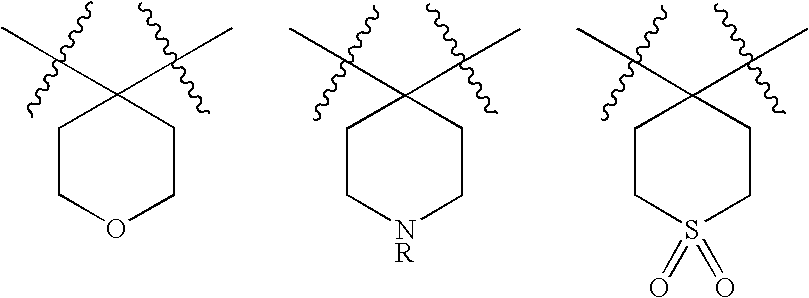Alpha ketoamide compounds as cysteine protease inhibitors
a cysteine protease inhibitor and alpha ketoamide technology, applied in the direction of peptides, drug compositions, immunological disorders, etc., can solve the problems of pathological consequences and the activeness of cysteine proteases
- Summary
- Abstract
- Description
- Claims
- Application Information
AI Technical Summary
Benefits of technology
Problems solved by technology
Method used
Image
Examples
example 2
[0269]Solutions of test compounds in varying concentrations were prepared in 10 μL of dimethyl sulfoxide (DMSO) and then diluted into assay buffer (40 μL, comprising: MES, 50 mM (pH 5.5); EDTA, 2.5 mM; and DTT, 2.5 mM). Human cathepsin K (0.0906 pMoles in 25 μL of assay buffer) was added to the dilutions. The assay solutions were mixed for 5-10 seconds on a shaker plate, covered and incubated for 30 min at room temperature. Z-Phe-Arg-AMC (4 nMoles in 25 μL of assay buffer) was added to the assay solutions and hydrolysis was followed spectrophotometrically at (λ 460 nm) for 5 min. Apparent inhibition constants (Ki) were calculated from the enzyme progress curves using standard mathematical models.
[0270]Compounds of the invention were tested by the above-described assay and observed to exhibit cathepsin K inhibitory activity.
example 3
[0271]Solutions of test compounds in varying concentrations were prepared in 10 μL of dimethyl sulfoxide (DMSO) and then diluted into assay buffer (40 μL, comprising: MES, 50 mM (pH 5.5); EDTA, 2.5 mM; and DTT, 2.5 mM). Human cathepsin L (0.05 pMoles in 25 μL of assay buffer) was added to the dilutions. The assay solutions were mixed for 5-10 seconds on a shaker plate, covered and incubated for 30 min at room temperature. Z-Phe-Arg-AMC (1 nMoles in 25 μL of assay buffer) was added to the assay solutions and hydrolysis was followed spectrophotometrically at (λ 460 nm) for 5 min. Apparent inhibition constants (Ki) were calculated from the enzyme progress curves using standard mathematical models.
[0272]Compounds of the invention were tested by the above-described assay and observed to exhibit cathepsin L inhibitory activity.
example 4
[0273]Solutions of test compounds in varying concentrations were prepared in 10 μL of dimethyl sulfoxide (DMSO) and then diluted into assay buffer (40 μL, comprising: MES, 50 mM (pH 6.5); EDTA, 2.5 mM; and NaCl, 100 mM); β-mercaptoethanol, 2.5 mM; and BSA, 0.00%. Human cathepsin S (0.05 pMoles in 25 μL of assay buffer) was added to the dilutions. The assay solutions were mixed for 5-10 seconds on a shaker plate, covered and incubated for 30 min at room temperature. Z-Val-Val-Arg-AMC (4 nMoles in 25 μL of assay buffer containing 10% DMSO) was added to the assay solutions and hydrolysis was followed spectrophotometrically (at λ 460 mn) for 5 min. Apparent inhibition constants (Ki) were calculated from the enzyme progress curves using standard mathematical models.
[0274]Compounds of the invention were tested by the above-described assay and observed to exhibit cathepsin S inhibitory activity of <or =100 nm.
PUM
| Property | Measurement | Unit |
|---|---|---|
| temperature | aaaaa | aaaaa |
| temperature | aaaaa | aaaaa |
| temperature | aaaaa | aaaaa |
Abstract
Description
Claims
Application Information
 Login to View More
Login to View More - R&D
- Intellectual Property
- Life Sciences
- Materials
- Tech Scout
- Unparalleled Data Quality
- Higher Quality Content
- 60% Fewer Hallucinations
Browse by: Latest US Patents, China's latest patents, Technical Efficacy Thesaurus, Application Domain, Technology Topic, Popular Technical Reports.
© 2025 PatSnap. All rights reserved.Legal|Privacy policy|Modern Slavery Act Transparency Statement|Sitemap|About US| Contact US: help@patsnap.com



